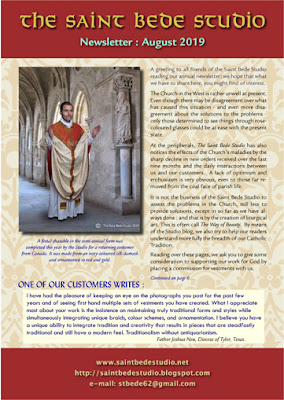In this post, let us discuss this from the perspective of mutually enriching the aesthetics of the two Forms for, although the external appearances are of a lesser degree of importance than the prayers and rituals of the Mass, these external forms do, nevertheless, make a strong impression upon those who look at them, namely the congregation.
For the purposes of this discussion, let us consider the scenario where both Forms of the Roman Rite are offered in the same Church or Parish, using the same sanctuary or altar and by the same priest and community.
 |
| The Benedictine Abbey of Le Barroux: Contemporary vestments intended for the Extraordinary Form. |
When the approach is taken that Baroque vestments must be used for the Extraordinary Form, we risk moving away from Tradition into the Re-Creation of bygone eras. Tradition isn't about Reaction or Re-Creation; that is a very shallow interpretation of Tradition and Continuity. Read more about that here.
In short, one obvious sort of mutual enrichment of the two Forms of the Roman Rite is when people observe that the same styles of vestments are appropriate for both and there is no required disjunct between the two.
Another is the manner in which altars are set up. Leaving aside the question of the Orientation of the Extraordinary Form, an altar may be set up for Low Mass in the Extraordinary Form simply with two candlesticks and a Crucifix, resting on the mensa of the altar. Tragically, some have now implemented the practice that, for the celebration of the Extraordinary Form, a timber shelf is placed on an altar, sometimes with a faux-tabernacle built into it, in order to make the altar seem more like "a Traditional High altar". This frightful practice is not only nonsense, it is also unliturgical. Is it not disrespectful of the dignity of a consecrated altar to place portable shelves on it?
 |
| Processional Cross as the altar Cross. |
You don't have to place six candlesticks on your altar for the Ordinary or Extraordinary Form. It became fashionable to do this, adopting what people referred to as the Benedictine Arrangement. Two good-sized, worthy candlesticks will do, particularly if the altar is a small one. If you do use a set of six candlesticks, make sure they are a matching set and proportionate to the altar.
Here is another suggestion: if you have a free-standing altar, locate the Processional Cross in the very centre of the altar (at the front of the altar for the Ordinary Form and at the back of the altar for the Extraordinary Form). Anciently, the Processional Cross was used this way before there was ever a thought of placing a Cross on the altar. A processional Cross so located can serve for both the Extraordinary and Ordinary Forms.
Secondly, then, ornament the altar for both Forms of the Roman Rite in much the same manner, even if the Orientation of the celebration is different.
 |
| Priestly crossing of the stole. |









